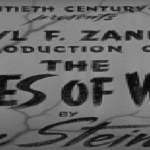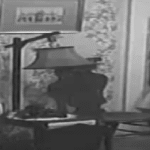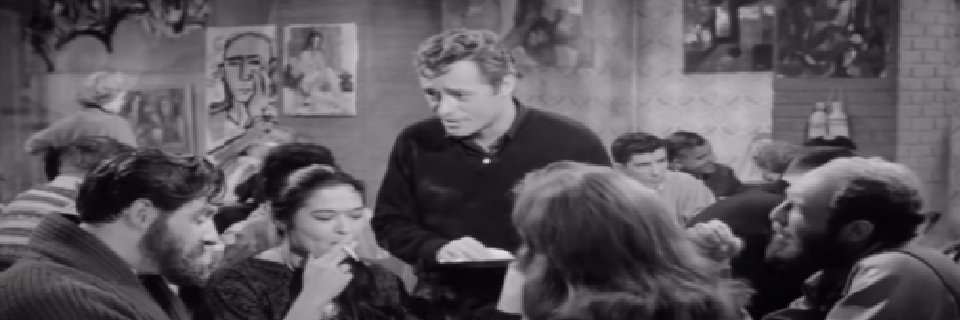A Bucket of Blood is a darkly comedic horror film directed by Roger Corman that satirises both the Beatnik culture of the 1950s and the pretensions of the art world. Set almost entirely in a small bohemian café, the film follows the tragicomic rise and fall of a hapless busboy who accidentally becomes an avant-garde sensation through murder.
The story centres on Walter Paisley, a timid and awkward young man working as a busboy at The Yellow Door Café, a beatnik coffee house frequented by poets, artists, and social misfits. Walter admires the confident artists and intellectuals around him, particularly Maxwell H. Brock, an arrogant poet who revels in delivering bombastic monologues about life, death, and art. Walter feels deeply inferior among these supposed elites and yearns to be respected and admired like them.
Walter’s idolisation extends to Carla, a kind and attractive hostess at the café who treats him with a measure of warmth, though she, like everyone else, underestimates him. Driven by a desperate desire to fit in and impress Carla, Walter dreams of becoming an artist himself, despite having no discernible talent.
One evening, back at his modest flat, Walter attempts to sculpt a figure out of clay but struggles miserably. His frustration is interrupted when his landlady’s cat, Frankie, becomes trapped inside the wall. In a clumsy attempt to free it, Walter accidentally stabs the cat to death. Distraught but inspired, he covers the cat’s body in clay, shaping it into a statue he titles “Dead Cat.”
Walter brings the sculpture to The Yellow Door the next day. To his amazement, the patrons are captivated by its raw “truth” and dark beauty, interpreting it as a profound artistic statement. No one suspects that the sculpture is, in fact, a real cat encased in clay. Leonard, the opportunistic café owner, immediately recognises the money-making potential and encourages Walter to create more “art.”
Emboldened by the praise, Walter becomes obsessed with maintaining his newfound status. However, lacking true artistic ability, he sees only one way forward: to continue using real bodies as the foundation for his work. His next victim is a nosy undercover policeman named Lou Raby, who suspects Walter of drug involvement. When Lou confronts him, Walter panics and bludgeons him to death with a frying pan. He then covers Lou’s body in clay, creating his next masterpiece, “Murdered Man.”
The acclaim only grows. Walter is lauded as a genius, invited to gallery showings, and fawned over by the very people who once ignored or mocked him. Yet as his fame increases, so too does his desperation. He realises he cannot keep up the façade without killing again, leading to a tragic and darkly humorous spiral.
Walter’s murders become increasingly brazen. He lures a model to his flat under the pretence of sculpting her, only to strangle her with cheesecloth and transform her into yet another grisly artwork. His growing collection of macabre sculptures—each hiding a grim secret—becomes the talk of the town.
Despite the outward success, Walter’s conscience gnaws at him. His unstable mental state deteriorates rapidly under the dual pressures of guilt and the need to produce. Meanwhile, Carla remains blissfully unaware of Walter’s crimes, encouraging him gently without realising the monstrous acts fuelling his creativity.
Eventually, Walter’s secrets begin to unravel. At an exhibition thrown in his honour, an art patron notices a human finger protruding from one of the sculptures. Panic erupts, and Walter, realising the game is up, flees into the night.
Haunted by the faces of his victims and the betrayal of the world he so desperately tried to impress, Walter returns to his flat. In a final, chilling act of self-destruction, he sculpts one last piece—himself. Using a noose to hang himself, Walter stages his own death as the ultimate “work of art.” When the authorities finally break in, they find his lifeless body encased in clay, dangling from the ceiling.
The film closes on a grimly ironic note: Walter, who wanted nothing more than to be accepted and remembered as a great artist, achieves a macabre sort of immortality—but only through his own destruction.
A Bucket of Blood deftly weaves horror, satire, and dark comedy into a compact, hour-long feature. At its core, the film is a biting critique of the pretentiousness of artistic subcultures. The Beatnik characters spout hollow philosophies and shower praise on works they do not understand, so long as they seem “authentic” or “avant-garde.” Walter’s grotesque sculptures are hailed as revolutionary, not because of their actual merit, but because they are shrouded in mystery and projected meaning.
Walter himself represents the everyman: invisible, insecure, and desperate for acknowledgement. His tragic arc from harmless busboy to serial killer underscores the dangers of blind ambition and the human desire for validation at any cost. His actions are horrifying, yet the film paints him as a sympathetic figure—a man manipulated by the shallow world he inhabits as much as by his own inadequacies.
Moreover, the film addresses the theme of authenticity versus fraudulence. Ironically, Walter’s “art” is brutally authentic in the worst way, while the community around him elevates it precisely because they misinterpret it. His success is a mirror to the pretensions of the art world, where genuine skill often matters less than the story—or shock value—behind a piece.
Roger Corman’s low-budget direction adds to the film’s charm. Shot in just five days on a shoestring budget, A Bucket of Blood uses minimal sets, a small cast, and clever dialogue to create an atmosphere that is both claustrophobic and vibrant. The Yellow Door café, with its smoky ambience and endless beat poetry, becomes a character in itself, embodying both the allure and absurdity of the culture it satirises.
Dick Miller’s portrayal of Walter Paisley is key to the film’s success. Miller imbues Walter with a blend of innocence, desperation, and creeping madness that makes his descent into horror both believable and tragic. His performance invites both pity and horror, anchoring the film’s tone perfectly between comedy and tragedy.
In the years since its release, A Bucket of Blood has gained cult classic status. Its influence can be seen in later black comedies and horror satires, and it remains a landmark film for its sharp commentary, clever storytelling, and uniquely sympathetic monster. Ultimately, A Bucket of Blood stands as a grim, funny, and poignant reminder that sometimes, the price of fame is far greater than the reward.







